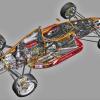Originally posted by fausto
Very rough reply...yes, (some) Group C cars had Venturi shaped underbodies, but they had to comply to rules that mandated a reference plate behind the front axle and a maximum height of the Venturi tunnels.
There was a minimun ride height, that was controlled solidly than with F.1s.
I think also that, being the weight of this kind of cars (heavier than Formulas) could have been a factor...
Gr C came into being for 1982, being primarily a fuel consumption formula, in order to allow a great variety of engines to power the cars, ie supercharged, turbocharged or atmospheric, stock-block or purpose-built racing power unit....and it worked well, too. Maximum weight was set at 800kgs, with no fuel or driver on board.
As far as aero regulations go, the original specs called for a flat reference plate, measuring 100x80cms,starting behind the back of the front wheels. No other parts were allowed to project below this plane, apart from the wheels.
Maximum length of complete car including wings was 480cms, width 200cms, and height between 100 and 110cms.
No air boxes were allowed forward of, or above, the highest parts of the screen. There were measurements for windscreen, for doors and for internal cockpit width (130cms), and for side window sizes (40x25cms). The front overhang was to be no more than 20% of the wheelbase,and the difference between front and rear overhangs was not to exceed 15% of the wheelbase. Maximum wheel rim width was 16". Venturii were permitted aft of the reference plate, but skirts were banned. Finally, the fuel tank was to be contained within the wheelbase of the car and within 65cms of the longitudinal axis of the car, fuel tank capacity being 100 litres.
For 1983, the C Junior class was introduced, broadly similar to the C1 cars but with a total wight of 700kgs and a fuel capacity of 55 litres. Interestingly, C Junior regs demanded pedals to be mounted aft of the front wheel centres, while C1 regulations did not not, at that time. Other than that, the FIA kept mucking about with fuel allowances and capacities, right through the life of Gr C. For 1984, there were some radical new regulations being bandied about by M. Balestre, including allowing IMSA spec cars to compete with Gr C...but to Gr C fuel allowances.
For 1985, C Junior officially became C2, and their tank capacity was raised to 100 litres. All cars manufactured after Jan 1st had to have the pedals mounted behind the front wheel axis, also aluminium roll cages were banned in favour of steel. Fuel allocation for 1000km races in C1 was 510 litres (5.53 mpg), and for C2 330 litres.
1986 saw and increase in length of the front crushable zone from 30 to 50cms, and the allowed rate of refuelling was increased from 50 litres/min to 60.
For 1987, exotic fuel blends were banned (toluene was out)...leading to the mass destruction of Porsche pistons in the first hours of the race at La Sarthe.
For 1988, the size of the reference plate was increased to the width of the full chassis, and length of 90cms for C1, 80 cms for C2. The height of the rear venturi was set at a maximum of 280mm. Fuel was to be 98,7 RON, and C2 fuel allowance increased slightly to 363 litres.
In 1989, the weight was increased to 900kgs dry, and to 750kgs for C2, and all races were now to be run for a length of 480 kms, with the exception of Le Mans. A Grand Touring class was included, and a new class for atmo engines of 3.5 litres and 750 kg weight - in other words, contemporary F1 mechanical bits with all-enclosed bodywork - was also introduced. C2 was eliminated for 1990, heralding the demise of the Championship as very few of the privateer teams - for so long, the backbone of endurance racing - had the means to go down the two-seater F1 route.













